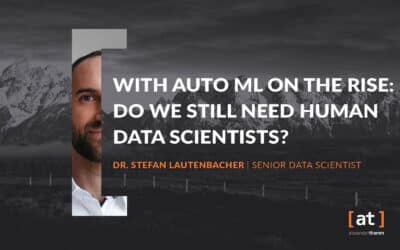Data-driven business models are the topic of this basic article, in which you will learn everything about the importance and future role of data in digitalised companies with the help of concrete examples.
The data-driven digitalisation is, on the one hand, a broad term that unites many different aspects. On the other hand, with all Digitisation projects Despite all the differences, there are also similarities and structural Similarities. One of these common denominators are: Data-driven business models. They are at the centre of the digital transformation of companies.
Description: Here we show with the help of a converted pinball machine how Data Scientists transform an analogue object.
A Study of the Information Services Group (ISG) recently showed that data-driven business models increasingly Distribution find. In 2017 alone, the market for data analytics and Big Data-driven models grew by 24 percent. According to the study, a sales volume of around 36 billion euros is expected in Germany alone by 2020.
Inhaltsverzeichnis
What are data-driven business models?
Data-driven business models can initially be seen as a consequence of the increasing Digitisation and Technologisation the Working world understand. Three developments play a role in this.
- Firstly: More and more Machines, Services and Sensors provide data and information.
- Secondly: At the same time Storage technology faster and cheaper, so that this data can be stored and processed effectively and economically.
- Thirdly: The digital networking helps with the Distribution of the data, so that they can be quickly and, thanks to the Cloud are available in many places.
Link tip: One of the important drivers of data-driven business models is the CloudWe have summarised their most important advantages.
At the heart of data-driven business models is the Added value generating utilisation of this data. In our experience, three categories can be identified into which the purposes of data-driven business models can be divided:
- Optimisation and Automation of processes, products or services
- The Transformation of existing business models
- The Development completely new Use Cases
Data-driven digitalisation is not being pursued as an end in itself, but is associated with Investments and Willingness to experiment connected. Innovations, the development of new markets or market areas as well as better scalability are often the overarching goal of data-driven business models.
Data knows no national borders - it is globally applicable
Data-driven business models have a decisive advantage: they are not limited to a specific region. The Language of the data is, so to speak universal. This means that if, for example, a machine builder has a Data product once developed, he can operate it just as well in Germany, China, the USA, Slovakia or Mexico.
Examples of data-driven business models
Three concrete examples that we have carried out will be used to show how data-based business models can work:
- OptimisationThanks to analytics models, it is possible in supply chain management to identify the component groups that cause the most costs and to use correlation analyses to evaluate suitable countermeasures to optimise demand planning and material control.
- Transformation: Development of a data strategy for the production and logistics of a German car manufacturer: The goal was to integrate new use cases into existing Industry 4.0 business areas on a data science basis. The result was a cross-departmental solution and a consistent development of data competences.
- InnovationConnected pinball: To make the IoT tangible, we have digitised a completely analogue product. The game is digitally visualised in real time. The pinball machine is networked with the help of two Raspberry Pis and a camera collects additional unstructured image data to analyse the course of the game and the scores.
X-as-a-Service - why these data-driven business models in particular will become increasingly relevant in the future
One of the most successful and still underestimated use cases of the Industry 4.0 is predictive maintenance. One of the effects of Predictive maintenance is that machines fail less frequently and a longer life have. But this also means that fewer machines will be sold in the future. For many companies, this means that they need new business models in order to continue to grow.
This is exactly where the X-as-a-Service business models come into play. Printing machines-as-a-service, robots-as-a-service, forklifts-as-a-service, etc. refer to new business models of companies that have largely digitised their products and production environment and are looking for new business models.
Link tip: In our article on the role of Artificial Intelligence in Industry 4.0 we show why AI in particular favours this development.
Data-driven business models pay off for all sides equally
The Products as a service Instead of selling them, it pays off for both sides. Customers from industry know that they only pay for what they really need, and machine manufacturers can always offer their networked products in the best possible way. wait and Maintain.
Another advantage of data-driven business models: The data collected provides an additional Added value. Printing machines in which Sensors monitor the operation also show how these machines are utilised. In this way they provide valuable Key figures - both for the companies that use these machines and for the manufacturers.
The growing importance and future role of data-driven business models
Data has become one of the most valuable assets of companies, along with buildings, machines, employees and capital. Many companies and organisations are only just beginning to explore how value can also be generated from this asset.
For this reason alone, data-driven business models are one of the most promising and fastest-growing business areas. But they are also a necessity for another reason that far too few companies are aware of. Because even business models that work today and with which companies have great success are no guarantee that this will still be the case in 5, 10 or 15 years. That is why current approaches and models must be put to the test so that companies can remain competitive in the future.











0 Kommentare